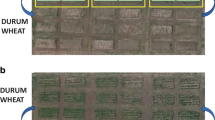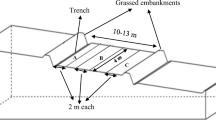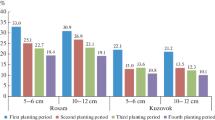Abstract
Purpose
Potato (Solanum tuberosum L.) is important to the world population’s food security. However, potato production is implicated in several environmental problems, particularly soil loss due to crop harvest (SLCH). Moreover, a knowledge bias about this process exists given that most related studies are from Europe. Most studies compare SLCH differences among tuber and root characteristics of distinct crops but not the tuber morphologies, e.g., spherical and elongated ones, within the same crop.
Aims
This study aimed to (a) estimate the SLCH in potatoes with contrasting morphologies in a very clayey soil; (b) test whether the potato morphology allied to soil moisture affects the sediment exportation.
Methods
A total of 205 potatoes from four plots were collected for morphological and sediment exportation assessments. Several morphological characteristics were measured: weight (g), volume (cm3), axis dimension (mm), concavities (the number and volume), sediment adherence (g), and soil moisture (g kg−1).
Results
The spherical potatoes exported 1.28 kg sediment per ton−1 of harvested potato, whereas the elongated ones exported 20% more sediment (1.54 kg). The harvested field with a high soil moisture content (≈ 26%) exported three times more sediment than the field with the lowest moisture content (≈ 16%).
Conclusions
The SLCH measured in the study area was lower (0.062 Mg ha−1 harvest−1) than most values reported in the literature. In addition, the potato morphological characteristics affected soil adherence at distinct soil moisture contents. The harvesting technique can be critical to reduce the SLCH.
Graphic abstract



Similar content being viewed by others
Data availability
All data are available under request and if necessary, data can be included in a public repository.
References
Bajželj B, Richards KS, Allwood JM et al (2014) Importance of food-demand management for climate mitigation. Nat Clim Chang 4:924–929. https://doi.org/10.1038/nclimate2353
Blanco-Canqui H, Lal R (2010) Principles of soil conservation and management. Springer, Dordrecht
Devaux A, Kromann P, Ortiz O (2014) Potatoes for Sustainable Global Food Security. Potato Res 57:185–199. https://doi.org/10.1007/s11540-014-9265-1
FAO (2019) Food and agriculture organisation of the United Nations. FAO, Quebec City
Faraji M, Amirian Chakan A, Jafarizadeh M, Mohammadian Behbahani A (2017) Soil and nutrient losses due to root crops harvesting: a case study from southwestern Iran. Arch Agron Soil Sci 63:1523–1534. https://doi.org/10.1080/03650340.2017.1296133
Gee GW, Bauder JW (1986) Particle-size analysis. Methods Soil Anal Part 1 Phys Mineral Methods 5:383–411
Gordon ND, McMahon TA, Finlayson BL et al (2004) Stream hydrology: an introduction for ecologists. Wiley, Hoboken
Govers G, Merckx R, Van Wesemael B, Van Oost K (2017) Soil conservation in the 21st century: why we need smart agricultural intensification. Soil 3:45–59. https://doi.org/10.5194/soil-3-45-2017
IBGE (2019) Instituto Brasileiro de Geografia e Estatística. Produção Agrícola—Lavoura Temporária—Batata. Município de Guarapuava, Guarapuava
Isabirye M, Ruysschaert G, Van linden L, et al (2007) Soil losses due to cassava and sweet potato harvesting: a case study from low input traditional agriculture. Soil Tillage Res 92:96–103. https://doi.org/10.1016/j.still.2006.01.013
Kaack LH, Katul GG (2013) Fifty years to prove Malthus right. Proc Natl Acad Sci USA 110:4161–4162. https://doi.org/10.1073/pnas.1301246110
Li Y, Ruysschaert G, Poesen J et al (2006) Soil losses due to potato and sugar beet harvesting in NE China. Earth Surf Process Landforms 31:1003–1016. https://doi.org/10.1002/esp.1304
Montanarella L, Pennock DJ, McKenzie N et al (2016) World’s soils are under threat. Soil 2:79–82. https://doi.org/10.5194/soil-2-79-2016
Mwango S, Msanya B, Mtakwa P et al (2015) Soil loss due to crop harvesting in Usambara Mountains, Tanzania: the case of carrot, onion and potato. Int J Plant Soil Sci 4:18–28. https://doi.org/10.9734/ijpss/2015/12479
Nitsche PR, Caramori PH, Ricce WS, Pinto LFD (2019) Atlas climático do estado do Paraná. IAPAR, Londrina
Oshunsanya SO, Yu H, Li Y (2018) Soil loss due to root crop harvesting increases with tillage operations. Soil Tillage Res 181:93–101. https://doi.org/10.1016/j.still.2018.04.003
Panagos P, Borrelli P, Poesen J (2019) Soil loss due to crop harvesting in the European Union: a first estimation of an underrated geomorphic process. Sci Total Environ 664:487–498. https://doi.org/10.1016/j.scitotenv.2019.02.009
Parlak M, Blanco-Canqui H (2015) Soil losses due to potato harvesting: a case study in western Turkey. Soil Use Manag 31:525–527. https://doi.org/10.1111/sum.12225
Parlak M, Palta Ç, Yokuş S et al (2016) Soil losses due to carrot harvesting in south central Turkey. CATENA 140:24–30. https://doi.org/10.1016/j.catena.2016.01.012
Parlak M, Çiçek G, Blanco-Canqui H (2018) Celery harvesting causes losses of soil: a case study in Turkey. Soil Tillage Res 180:204–209. https://doi.org/10.1016/j.still.2018.03.011
Poesen JWA, Verstraeten G, Soenens R, Seynaeve L (2001) Soil losses due to harvesting of chicory roots and sugar beet: an underrated geomorphic process? CATENA 43:35–47. https://doi.org/10.1016/S0341-8162(00)00125-9
Prăvălie R (2021) Exploring the multiple land degradation pathways across the planet. Earth-Sci Rev 220:103689. https://doi.org/10.1016/j.earscirev.2021.103689
Rickson RJ, Deeks LK, Graves A et al (2015) Input constraints to food production: the impact of soil degradation. Food Secur 7:351–364. https://doi.org/10.1007/s12571-015-0437-x
Ruysschaert G, Poesen J, Verstraeten G, Govers G (2004) Soil loss due to crop harvesting: signficance and determining factors. Prog Phys Geogr 28:467–4501. https://doi.org/10.1191/0309133304pp421oa
Ruysschaert G, Poesen J, Auerswald K et al (2007a) Soil losses due to potato harvesting at the regional scale in Belgium. Soil Use Manag 23:156–161. https://doi.org/10.1111/j.1475-2743.2006.00077.x
Ruysschaert G, Poesen J, Verstraeten G, Govers G (2007b) Soil loss due to harvesting of various crop types in contrasting agro-ecological environments. Agric Ecosyst Environ 120:153–165. https://doi.org/10.1016/j.agee.2006.08.012
Ruysschaert G, Poesen J, Notebaert B et al (2008) Spatial and long-term variability of soil loss due to crop harvesting and the importance relative to water erosion: a case study from Belgium. Agric Ecosyst Environ 126:217–228. https://doi.org/10.1016/j.agee.2008.01.027
Salvador CA (2019). Departamento de Economia Rural—DERAL. Prognóstico Olericultura. Análise da Conjuntura 1—Aspectos da Olericultura Paranaense técnicos do Departamento de Economia Rural com os números de área, produção e valor da produção rural de 50 (cinquenta) espécies. Curitiba
Silva FC (2009) Manual de análises químicas de solos, plantas e fertilizantes. Embrapa Informação Tecnológica. Embrapa Solos Brasília, Rio de Janeiro
Sumithra R, Thushyanthy M, Srivaratharasan T (2013) Assessment of soil loss and nutrient depletion due to cassava harvesting: a case study from low input traditional agriculture. Int Soil Water Conserv Res 1:72–79. https://doi.org/10.1016/S2095-6339(15)30041-1
Tiessen K, Lobb D, Mehuys G (2007) The canon of potato science: 30. Tillage erosion within potato production—soil tillage, earthing up and planting. Potato Res 50:327–330. https://doi.org/10.1007/s11540-008-9055-8
Veeck G, Veeck A, Yu H (2020) Challenges of agriculture and food systems issues in China and the United States. Geogr Sustain 1:109–117. https://doi.org/10.1016/j.geosus.2020.05.002
Vitti GC (1989) Avaliação e interpretação do enxofre no solo e na planta. FCAV, UNESP, São Paulo
Walkley A, Black IA (1934) An examination of the Degtjareff method for determining soil organic matter, and a proposed modification of the chromic acid titration method. Soil Sci 37:29–38
Yu HQ, Li Y, Zhou N et al (2016) Soil nutrient loss due to tuber crop harvesting and its environmental impact in the North China Plain. J Integr Agric 15:1612–1624. https://doi.org/10.1016/S2095-3119(15)61268-0
Zingg T (1935) Beitrag zur schotteranalyse. Schweitz Mineral Petrog Mitt 15:38–140
Acknowledgements
To Trindade farm owners. Authors also thank Eduardo Galeski, Thereza Christina Lampugnani, Claudiane da Costa and Mirian Covalski for field support. And to Dr. Jackson Kawakami for his friendly review that is help improves this paper.
Funding
The research was supported by the Conselho Nacional de Desenvolvimento Científico e Tecnológico (CNPq-Brazil—Grant No. 301665/2017-6).
Author information
Authors and Affiliations
Contributions
ELT: conceived of the idea-Methods, conceived and planned the experiments and wrote the manuscript. JB: carried out the experiment and performed the measurements in field and in laboratory.
Corresponding author
Ethics declarations
Conflict of interest
The authors declare that they have no known competing financial interests or personal relationships that could have appeared to influence the work reported in this paper.
Additional information
Communicated by Peter J. Gregory.
Publisher’s note
Springer Nature remains neutral with regard to jurisdictional claims in published maps and institutional affiliations.
Rights and permissions
About this article
Cite this article
Thomaz, E.L., Bereze, J. Soil loss due to crop harvest in Southern Brazil: effect of potato morphology. Plant Soil 468, 67–76 (2021). https://doi.org/10.1007/s11104-021-05114-5
Received:
Accepted:
Published:
Issue Date:
DOI: https://doi.org/10.1007/s11104-021-05114-5




